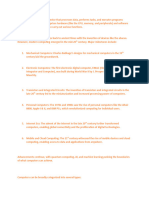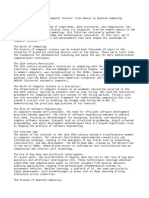0% found this document useful (0 votes)
5 views11 pagesStudy Notes
The document provides an overview of Computer Science, covering its definition, history, hardware, software, algorithms, data structures, databases, networking, cybersecurity, artificial intelligence, and future trends. It highlights key figures and concepts that have shaped the field, such as Turing, the Analytical Engine, and the importance of data management and security. Emerging technologies like quantum computing and AI are discussed as influential in the future of computing.
Uploaded by
extrabot46Copyright
© © All Rights Reserved
We take content rights seriously. If you suspect this is your content, claim it here.
Available Formats
Download as PDF, TXT or read online on Scribd
0% found this document useful (0 votes)
5 views11 pagesStudy Notes
The document provides an overview of Computer Science, covering its definition, history, hardware, software, algorithms, data structures, databases, networking, cybersecurity, artificial intelligence, and future trends. It highlights key figures and concepts that have shaped the field, such as Turing, the Analytical Engine, and the importance of data management and security. Emerging technologies like quantum computing and AI are discussed as influential in the future of computing.
Uploaded by
extrabot46Copyright
© © All Rights Reserved
We take content rights seriously. If you suspect this is your content, claim it here.
Available Formats
Download as PDF, TXT or read online on Scribd
/ 11
























































